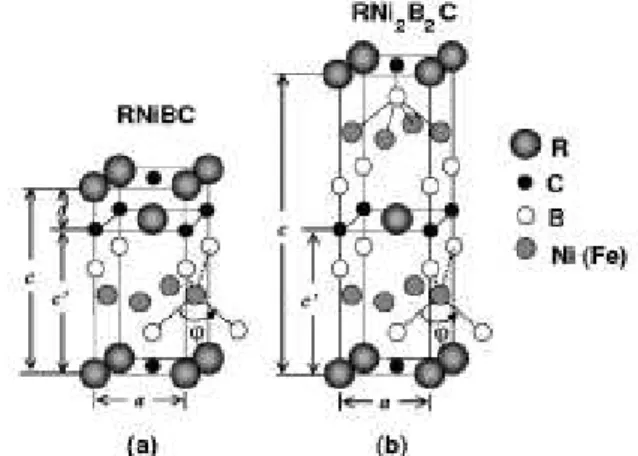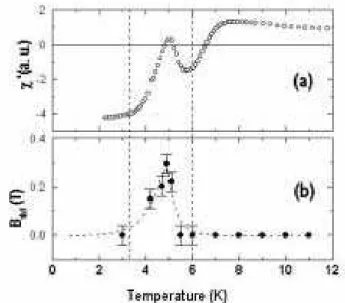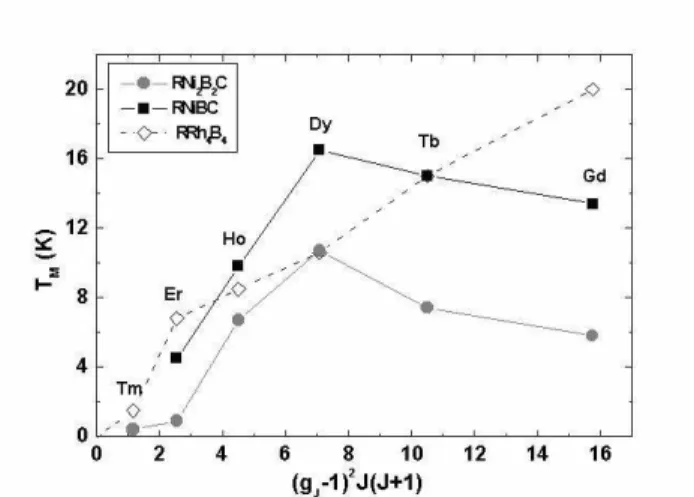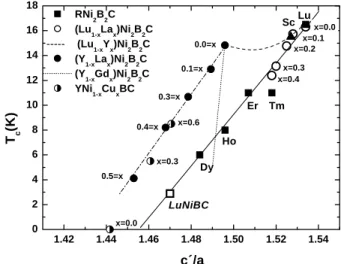Magneti and Strutural Features of
RNi
2 B
2
C and RNiBC (R=Er, Ho, Dy, Tb, Gd)
Superonduting Compounds
E.M. Baggio-Saitovith,D. R. Sanhez, and H. Miklitz
Centro BrasileirodePesquisas Fsias,
RuaDr. XavierSigaud150,Ura, CEP22290-180Riode Janeiro, Brazil
Reeivedon28February,2002
TemperaturedependentMossbauerspetrosopyon 57
Fedoped(1at%ofNi)RNi2B2CandRNiBC
providedlearevideneofapair-breakingeldattheNisitefornon-superondutingompounds.
ThiseldisnotpresentinthesuperondutingollinearAFDyNi2B2C,howeveritappearswhen
thisompoundisdilutedwithnon-magnetiLu(Dy
1 x Lu
x Ni
2 B
2
C).Importantloalinformationon
thespinstrutureoftheRmagnetimomentsisobtainedforbothsystems.Theloalsymmetriesof
RNi
2 B
2
CandRNiBCompounds,measuredthroughtheE
Q
,werefoundtobelinearlyorrelated
with the 0
=a ratio ( 0
is the distane of the R-C layers between whih the Ni2-B2 layers are
sandwihed). AsalingofTwiththeloalsymmetry( 0
=a)was foundtobethesameforall the
RNi
2 B
2
CandRNiBC(exeptfor Y)ompounds.
I Introdution
The interplaybetweensuperondutivityand
magnet-iallyordered strutures, whih isthe main reasonfor
the great interest in the RNi
2 B
2
C ompounds,
essen-tially doesnot exist forthe RNiBCfamily [1-5℄,sine
with the exeption of LuNiBC [3℄ none of these
om-poundshasbeenfoundtobesuperonduting. Inorder
tounderstandwhythisisthease,despitethefatthat
the strutures of both lasses of ompounds are very
similar, exept for an additional R-C layer (next
se-tion), wehavestudiedin detailrystallographi
stru-ture, magneti ordering and transport properties of
RNiBC (R= Er, Ho, Dy, Tb, Gd) ompounds.
Es-peially 57
FeMossbauerEet(ME)spetrosopyon1
at % 57
Fe-dopedRNi
2 B
2
Cand RNiBChas beenused
to study theloalstruture attheFe(Ni)siteviathe
nulearquadrupolesplittingandthemagnetiorderof
the Rmagnetimomentsviathetransferred magneti
hyperneeld.
II Struture
ThesimilaritiesbetweentheRNi
2 B
2
CandtheRNiBC
strutureareillustratedin Figs. 1(a)and(b): whilein
RNi
2 B
2
C [(RC)
1 (NiB)
2
℄ there are alternatinglayers
of R-Cand Ni
2 -B
2
, anadditionalR-C layerexists
be-tweentheNi
2 -B
2
layersintheRNiBC[(RC)
2 (NiB)
2 ℄
series. Thus, in both lasses of ompounds the
Ni -B layers, whih are responsible for
superondu-tivity,are sandwihed betweentwoR-C layers. These
Ni
2 -B
2
layersarebuiltfromNiB
4
tetrahedrawitha
B-Ni-B bonding angle ' as indiated in gs. 1(a) and
(b). In RNiBC series the lattie parameters and d
[see g 1(a)℄turned out to be essentiallyindependent
ofRwith=7.55
Aandd=2.41
A[4,5℄.InRNi
2 B
2 C(see
Fig. 1(b)) (=a) =2( 0
=a), with 0
beingthe distane
oftheR-Clayersbetweenwhih theNi
2 -B
2
layersare
sandwihed and a being the lattie parameter in the
basal plane [6℄. In theRNiBC ompounds 0
is given
by 0
= d(Fig. 1(a)).
Figure1. Crystalstruturesofunitellof(a)RNiBC and
(b)RNi
2 B
2
Compounds. Therelevant lattie parameters
aand 0
ThejE
Q
jvaluesforRNiBC(R=Er, Ho,Dy,Tb,
Gd)andforRNi
2 B
2
C(R=Er,Ho,Dy,Tb,Gd,Nd,Pr)
[7,8℄areplottedinFig. 2asafuntionofthestrutural
parameter ( 0
=a) whih is a measure for the B-Ni-B
bondingangle'[see Figs. 1(a)and(b)℄.
1.35
1.40
1.45
1.50
1.55
0.0
0.1
0.2
0.3
0.4
0.5
0.6
Y
Pr
Nd
Gd
Tb
Dy
Ho
Er
Gd
Tb
Dy
Ho
Er
RNiBC
RNi
2
B
2
C
|
∆∆∆∆
E
Q
| (
mm/
s
)
c'/a
Figure 2. Room temperature quadrupole splitting jEQj
observed in RNiBC (R = Gd, Tb, Dy, Ho, and Er) and
RNi2B2C(R=Pr,Nd,Gd,Tb,Dy,Ho,Er)ompoundsas
afuntionofthe('/a)-ratio.
Fig. 2 shows that all ompounds, RNi
2 B
2 C as
well as RNiBC, have the same linear orrelation
be-tween ( 0
=a) and jE
Q
j. This learly indiates that
boththe rystallographi and the eletroni struture
(whih determine E
Q
) at the Fe(Ni) site in RNiBC
and RNi
2 B
2
C ompounds are very similar for equal
struturalparameter( 0
=a). Furthermore,sinejE
Q j
is a measure for the deviation from ideal tetrahedral
symmetry, we have to onlude from Fig. 2 that
the NiB
4
tetrahedra in RNiBC ompounds displays
stronger deviation from ideal tetrahedral symmetry
than theRNi
2 B
2
C ompounds. Consideringthe band
struture alulations by Mattheiss et al [9℄, whih
have shown that ideal tetrahedral symmetry of the
NiB
4
tetrahedrahappenstooinidewitharelativehigh
densityofstatesattheFermienergy,itbeomesevident
whythestrutureoftheRNiBCompoundsisless
fa-vorableforsuperondutivitythanthatoftheRNi
2 B
2 C
ompounds(see setionIV).
III Magnetism
HoNi
2 B
2
CordersantiferromagnetiallyatT
N
=8.5 K
andbeomessuperondutorat8K.An
inommensu-rate modulated magneti struture appears at 6 K,
whihseemstoberesponsibleforthereentrant
behav-ior, i.e., the suppressionof superondutivitybetween
4:7K < T < 6K (Fig. 3(a)).
Figure3. (a)
a
showing therangeof temperaturewhere
the reentrant behavior oursand (b)B
thf
at the Ni site
obtainedfortheH
0 (Ni
0:99 57
Fe
0:01 )
2 B
2
Compound.
Thelossof superondutivity inthis rangeof
tem-perature is attributed to the appearane of a
pair-breaking eld at theNi layer, where 57
Fe probe is
lo-ated. ThetransferredmagnetihyperneeldB
thf at
theNi( 57
Fe)site,resultingfromthefournearest
neigh-borofHoatoms(twofromtheHolayeraboveandtwo
fromtheHolayerbelowtheNiplane),willnotanelin
theinterval4:7K < T < 6K,duetothe
inommen-surate antiferromagneti struture of HoNi
2 B
2 C. The
B
thf
as a funtion of the temperature (Fig. 3(b)),
showslearlythat suhamagneti pairbreaking eld
indeedexistsin thereentrantregionfortheHoNi
2 B
2 C
ompound. Apair-breakingeld(transferredhyperne
eld)wasobservedattheNisiteandalsosuppresses
su-perondutivityinTbNi
2 B
2
C[10℄andGdNi
2 B
2 C[11℄.
Suhkindofpairbreakingeld isnotobservedin ase
of DyNi
2 B
2
Cand ErNi
2 B
2
C,where superondutivity
oexistswithmagnetiorder[12℄.
The superondutivity in the ollinear AF
super-ondutorDyNi
2 B
2
Creliesonthedeliateanelingof
the ordered magneti moments on the Ni site. As a
onsequene,noB
thf
wasobservedatanytemperature
in this ompound. On the other hand, the doping of
DyNi
2 B
2
Cwithothernon-magnetielements(e.g. Lu),
Dy
1 x Lu
x Ni
2 B
2
C,disturbthisbalaneandwouldyield
totheappearingofanetB
thf
attheNisite,suhthat
Lushould atlikeamagnetiimpurity. So,a
dereas-ing of T
with the Lu doping, in agreement with the
Abrikosov-Gor'kovtheory,wasobserved[13℄.
Further-more,theseelementsintroduedisorderinthe4f-spin
systemsuhthatsimultaneouslyT
N
alsodereaseswith
dopingonentration. LowtemperatureMossbauer
ex-periments on non-superonduting Dy
0:8 Lu
0:2 Ni
2 B
2 C
pairbreakingeld.Fig. 4showstheBt
hf
,asafuntion
ofthetemperatureforDy
0:8 Lu
0:2 Ni
2 B
2 C.
ThemagnetiorderingtemperaturesT
M
ofRNiBC
(R=Er, Ho, Dy, Tb, Gd) have been determined by
AC suseptibility measurements[5℄. We have plotted
these values forthe dierentompounds in Fig. 5
to-gether with those of the orresponding RNi
2 B
2 C and
RRh
4 B
4
ompoundsasafuntionofthedeGennes
fa-tor. Whilethe T
M
valuesoftheRNi
2 B
2
Compounds
nielyfollowalinearrelationwiththedeGennesfator
(see Fig. 5) this is not the ase for the RNiBC
om-poundswhere T
M
forDy andTbareevenhigherthan
that for Gd (see Fig.7). This nding is very similar
tothatfoundforferromagneti (FM)orderedRRh
4 B
4
ompoundswhereagainthehighestT
M
doesnotour
forGdbutforDy(Fig. 5). Crystaleldeetshave
ex-plained thisfatwhihenhane T
M
ofFM ompounds
in suh a waythat T
M
of TbRh
4 B
4
and DyRh
4 B
4 is
higher thanthat of GdRh
4 B
4
[14℄. As it isshown
be-low, DyNiBC and TbNiBC have a FM struture just
belowT
.
0
1
2
3
4
5
6
7
8
9
10
11
0.00
0.05
0.10
0.15
0.20
0.25
0.30
0.35
0.40
0.45
x=0.2
Dy
Dy
Dy
Dy
1-x
1-x
1-x
1-x
Lu
Lu
Lu
Lu
x
x
x
x
Ni
Ni
Ni
Ni
2
2
2
2
B
B
B
B
2
2
2
2
C
C
C
C
B
hf
(T)
Temperature(K)
Figure 4. B
thf
at the Ni site obtained for the
Dy
0:8 Lu
0:2 (Ni
57
0:99 Fe
0:01 )
2 B
2
Compound.
From the analysis of magnetoresistane data for
RNiBC (R=Er,Ho, Dy, Tb , Gd) [5℄oneobtainsFM
oupling for Er, Dy and Tb, orroboratedby reently
neutron diration data [15℄. 57
Fe ME studies below
T
M
forRNiBC(R=Er,Ho,Dy, Tb,Gd)showa
mag-netihyperneeldat theFe (Ni)nuleusforTband
Er,againinagreementwithneutronand
magnetoresis-tane data. No magnetihyperneeld,on the other
hand, wasobservedfor Ho,Dy and Gd. Whilethisis
in agreementwiththe otherexperimental data forHo
andGd, theabsenthfeld inDyNiBCisapuzzle.
Figure 5. Magneti transition temperatures TM for the
RNi2B2C [6℄, RNiBC [5℄ and RRh4B4 [14℄ ompounds as
afuntionofthedeGennesfator.
IV Superondutivity
The T
of the heavy magneti rare earth RNi
2 B
2 C
has been found to derease linearly with inreasing
deGennes fator(g
J -1)
2
J(J+1) [16℄. This orrelation
pointed the magneti pair-breaking as the dominant
eet in determine the depression of T
in magneti
RNi
2 B
2
Compounds but doesnotexplain the
behav-iorof nonmagneti Lu, Y and La. However, a
dier-ent approah, in whih the strutural eets seem to
playan important rolein determiningthe variationof
T
in therareearth-nikel-boroarbides(inludingthe
magnetiandnon-magnetiRNi
2 B
2
C,andtheir
oun-terpartsRNiBC),willbeshownbelow.
A deviation of the ideal tetrahedral symmetry of
theNiB
4
ofLuNi
2 B
2
Canbeobtainedexperimentally
doping the Lu site with the nonmagneti La. Being
theioniradiusoftheLadierentfromLuthedoping
willleadtoahangein the( 0
=a) parameter. Beause
thesesamplesarenonmagneti,thereisnomagneti
in-ueneon superondutivity and the depressionof T
will be determined only by strutural eets (hange
of ( 0
=a) parameter). The above arguments are also
validfor YNi
2 B
2
Cif doped withLa. In viewof these
fats wedeided toprepare theLu
1 x La
x Ni
2 B
2 C and
Y
1 x La
x Ni
2 B
2
Calloys.
Inorderto seeifthere isanyrelation betweenthis
strutural parameter and the superonduting
tran-sition temperature T
we have plotted in Fig. 6
the T
value for LuNiBC [3℄ together with those for
the non-magneti RNi
2 B
2
C (R=Lu, S) ompounds,
the non-magneti mixtures (Lu
1 x La
x )Ni
2 B
2 C [17℄,
(Y
1 x La
x )Ni
2 B
2
C [18℄ and the magnetially ordered
RNi
2 B
2
C(R=Tm,Er, Ho,Dy)ompounds. The
non-magneti LuNi
2 B
2
C, SNi
2 B
2 C, (Lu
1 x La
x )Ni
2 B
2 C
andLuNiBCshowalinearrelationbetween( 0
=a)and
T
(see solid line in Fig. 6). The non-magneti
between( 0
=a) andT
(seedashed linein Fig. 6)with
a slope whih is idential to that for the other
non-magnetiompounds. ThisslopeofT
vs(
0
=a),thusis
ameasureforthedereaseofT
withinreasing( 0
=a).
The T
values found for (Y
1 x La x )Ni 2 B 2 C are
higher (for the same ( 0
=a) value) than those of
RNi
2 B
2
Cfamilyofboroarbides. Asmentionedin
se-tionII,this feature islikelyrelated withthe fat that
the Y doesnot behave as a rare earth in these series
of ompounds, whih is also observed in the Chevrel
phases[19℄.
TheYNiBC beomessuperondutingwhen doped
with Cu [20℄, and their T
vs
0
=a plot follows quite
thesametrendobservedfortheY
1 x La x Ni 2 B 2 Cseries
(Fig. 9). Despitethefatthatinthisasethereours
ahange in the densityof states at the Fermi levelit
seemsthatagainastruturalhangeisrelevantforthe
hangeinT
whentheCusubstitutestheNiinYNiBC.
Quite surprisingly the magnetially ordered
RNi
2 B
2
C (R=Dy, Ho, Er) ompounds with T
N lose
to T
are on the same line asthe non-magneti
om-pounds. Only T
of TmNi
2 B
2
C with T
N
<< T
is
slightly below the line (see Fig. 6), indiating that
there is alear paramagneti pair-breaking eet due
to exhange satteringin theframework of
Abrikosov-Gorkov theory for this ompound. Thus, the pair
breakingeet oftheRmagnetimomentseemsto be
verysmall for Dy, Ho, Er and it is T
-2 K for
Tm. This nding is quitein ontrastto the generally
aepted opinion that T
in all magnetially ordered
RNi
2 B
2
CompoundssaleswiththedeGennesfator
[6,16℄. However, it is in perfet agreement with very
reent theoretial alulations [21℄ whih have shown
that the Ni(3d), eletrons whih are mainly
responsi-ble for superondutivity, do not feel the R magneti
momentsintheasethattheRmagnetimomentsare
antiferromagnetiallyordered,i.e. forDyandHo.
In the R
1 x R' x Ni 2 B 2
C pseudoquaternary alloys,
where one of them is magneti (e.g. R = Lu or Y
and R' = Gd [11,22℄), T
will derease aording to
Abrikosov-Gorkovtheory. Inthisase,thepair
break-ing eet ismoreeetive in redutionofT
thanthe
struturaleet(hangeof 0
=a)andannotbe
onsid-eredin ourlinearrelationofT
with( 0
=a).
Taking into aount what was disussed above,
the ( 0
=a) parameter (a measure of the distortion of
the NiB
4
tetrahedra) seems to be a relevant
param-eter, whih determines T
in all non-magneti and
antiferro-magnetially ordered RNi
2 B
2
C and RNiBC
ompounds. Ontheotherhand,theT
salewith( 0
=a)
ratioandthedeGennesfatorinasimilarwayforthe
heavyrareearthRNi
2 B
2
C.However,inthe
Abrikosov-Gorkovframeworkisnotpossibletoexplainthe
dier-enes in T
of thenonmagnetiLuNi
2 B 2 C, SNi 2 B 2 C, YNi 2 B 2 C, LaNi 2 B 2
C, and the R-C double layer
LuNiBC ompound.
1.42
1.44
1.46
1.48
1.50
1.52
1.54
0
2
4
6
8
10
12
14
16
18
x=0.6
x=0.3
x=0.0
LuNiBC
x=0.2
x=0.4
x=0.3
x=0.1
x=0.0
Sc
0.5=x
0.4=x
0.3=x
0.1=x
0.0=x
Lu
Tm
Er
Dy
Ho
T
c
(K)
c´/a
RNi
2
B
2
C
(Lu
1-x
La
x
)Ni
2
B
2
C
--- (Lu
1-x
Y
x
)Ni
2
B
2
C
(Y
1-x
La
x
)Ni
2
B
2
C
(Y
1-x
Gd
x
)Ni
2
B
2
C
YNi
1-x
Cu
x
BC
Figure 6. Superonduting transition temperatures of
RNi2B2C [6℄, (Lu1 xLax)Ni2B2C [17℄, (Y1 xLax)Ni2B2C
[18℄,LuNiBC[3℄,andYNi
1 x Cu
x
BC[20℄.
The superonduting properties of the RNi
2 B
2 C
phasesareattributedtoaneletron-phononmehanism
[9℄. Although the Fermi eletrons in these materials
have predominant Ni(3d) harater, the
superondu-tivity ours only when a speial s p band is
opti-mallyalignedrelativetotheFermilevel(i.e.,whenthe
NiB
4
tetrahedra angles are nearly \ideal")and whih
exhibitsstrongeletron-phononoupling[9℄.
Sineweexpetthatthestruturebyitselfannot
determine T
, morework is neessaryto eluidate the
role of the strutural eets on the eletron-phonon
oupling, whih seems to be essential to desribe the
nature ofthedepressionofT
in therare
earth-nikel-boroarbidesseriesofompounds.
V Conlusion
57
FeMossbauerspetrosopyon 57
FedopedRNi
2 B
2 C
showatransferredhyperneeldattheFe(Ni)nuleus
for theompounds wheresuperondutivityis not
ob-served (TbNi
2 B
2
Cand GdNi
2 B
2
C)and where the
su-perondutivitydisappearsinertainregionof
temper-ature (HoNi
2 B
2
C in the reentrant region)and doping
(Dy 0:8 Lu 0:2 Ni 2 B 2
C, below T
N
). This transferred
hy-perneeldisinterpretedasaeldoriginatingfromthe
magneti momentsoftheneighboringR atoms, whih
areinaspinongurationdierentthatommensurate
antiferromagneti,and atsasapair-breaking eld at
theNisite. 57
FeMossbauerresultsinRNiBCindiatea
ferromagnetispinstrutureforTbNiBCand ErNiBC
andantiferromagnetioneforHoNiBC.Eletrialeld
gradient measurements at Fe site show that the NiB
4
tetrahedra in RNiBCdisplaysstrongerdeviation from
\ideal"tetrahedralsymmetry(asthatLuNi
2 B 2 C)than theRNi 2 B 2
Compounds. Thesamelinearrelation
be-tweenT
and(
0
=a)wasfoundforthemagnetiaswell
indiating that strutural eets may be essential for
the establishment of the superonduting state in the
rare-earth-nikel-boroarbides.
Aknowledgements
Wethankthenanialsupportfrom FAPERJ/RJ,
VW Foundation, Capes/Brazil, CNPq/Brazil and
DAAD/GermanyD.R.S.thanksLatinAmerian
Cen-ter forPhysis(CLAF)forhisPost-dofellowship.
Permanent address: II. Physikalishes Institut,
UniversitatzuKoln,Zulpiherstr.77,50937Koln,
Ger-many
Referenes
[1℄ T.Siegrist, H.W.Zandbergen,R.J.Cava,J.J.
Kra-jewski,andW.F.Pek Jr.Nature(London)367,254
(1994).
[2℄ L. J. Chang, C. V. Tomy, D. MK Paul, N. H.
An-dersen,andM.Yethiraj,J.Phys.: Condens.Matter8,
2119 (1996).
[3℄ L.Gao,X.D.Qui,Y.R.L.Cao,Meng,Y.Y.Sun,Y.
Y. Xue,and C.W.Chu,Phys. Rev.B 50,9445-9448
(1994).
[4℄ Q. Huang, J. W. Lynn, A. Santoro, B. C.
Chak-oumakos,R.J.Cava,J.J.Krajewski,andW.F.Pek
Jr,PhysiaC271,311(1996).
[5℄ M. B. Fontes, J. C.Trohez, M. A. Continentino, B.
Giordanengo, S.L.Bud'ko,D.R.Sanhez,andE.M.
Baggio-Saitovith,Phys.Rev.B60,6781(1999).
[6℄ J.W.Lynn,S.Skanthakumar,Q.Huang,S.K.Sinha,
Z.Hossain,L.C.Gupta,R.Nagarajan,andC.Godart,
Phys.Rev.B55,6584(1997).
[7℄ Z.Zeng,D.R.Sanhez,DianaGuenzburger,D.E.
El-lis, E. M. Baggio-Saitovith, and H. Miklitz, Phys.
Rev.B55,3087 (1997).
[8℄ D. R. Sanhez, H. Miklitz, and E. M.
Baggio-Saitovith, J. Phys. : Condens. Matter 12, L177
(2000).
[9℄ L.F.Mattheiss,T.Siegrist,andR.J.Cava,SolidState
Commun:91,587(1994).
[10℄ D.R.Sanhez,S.L.Bud'ko,E.M.Baggio-Saitovith,
M. Hillberg, W. Wagener, H.-H. Klauss, G. H. Walf,
andF.J.Litterst.Phys.Rev.B,5710268(1998).
[11℄ D. R. Sanhez, H. Miklitz, and E. M.
Baggio-Saitovith,J.Phys.: Condens.Matter9,L299(1997).
[12℄ D.R.Sanhez,H.Miklitz,M.B.Fontes,S.L.Bud'ko,
andE.M.Baggio-Saitovith,Phys.Rev.Lett.76,507
(1996).
[13℄ B.K.Cho,P.C.Caneld,and D.C.Johnston,Phys.
Rev.Lett.77,163(1996).
[14℄ B.D.Dunlap,L.N.Hall,F.Behroozi,G.W.Crabtree,
andD.G.Niarhos,Phys.Rev.B29,6244(1984).
[15℄ F. Bourdarot, J. W. Lynn, E. Baggio-Saitovith, Q.
Huang, D. R. Sanhez, and S. Skanthakumar. Phys.
Rev.B64,104410(2001)
[16℄ P.C.Caneld,B.K.Cho,andK.W.Dennis,Physia
B215,337(1995).
[17℄ D.R.SanhezandE.M.Baggio-Saitovith,tobe
pub-lished.
[18℄ D. R. Sanhez, S. L. Bud'ko, and E. M.
Baggio-Saitovith,J.Phys.: Condens.Matter12,9941(2000)
[19℄ .Fisher,Appl. Phys.16,1(1978).
[20℄ A.K.Gangopadhyayand J.S.Silling, Phys.Rev.B
54,10107(1996)andCava,R.J.inthisproeeding.
[21℄ HyeonjinDoh,ManfredSigrist,B.K.Cho,andSung-Ik
Lee,Phys.Rev.Lett.83,5350(1999).
[22℄ M. El Massalami, S. L. Bud'ko, B. Giordanengo, M.
B.Fontes,J.C.Mondragon,E.M. Baggio-Saitovith,



